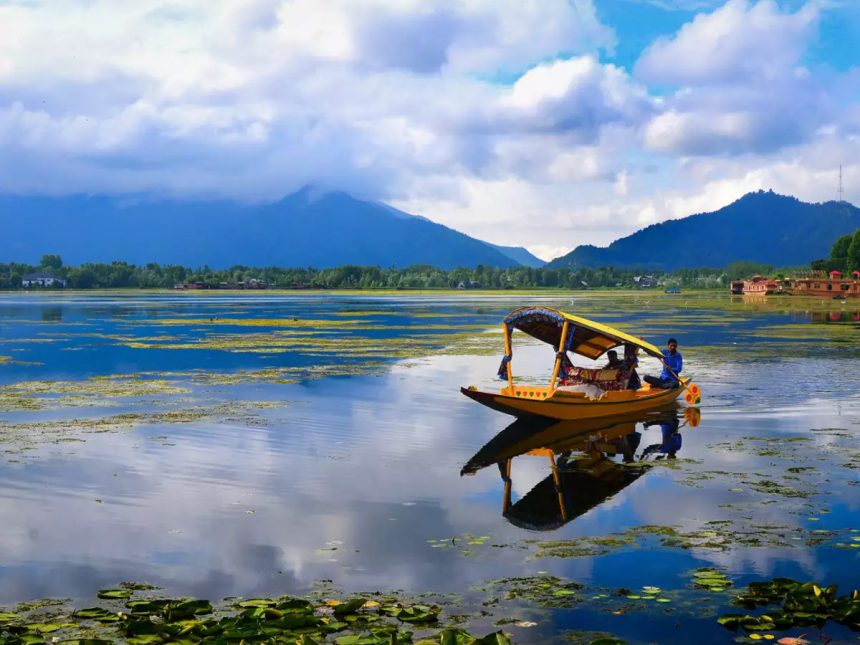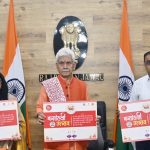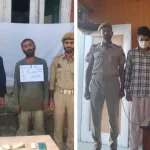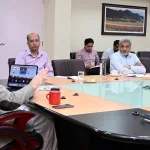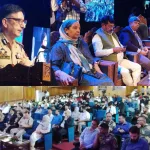Six years have passed since the Government of India made the historic move to abrogate Article 370, altering the constitutional status of Jammu & Kashmir and integrating it more directly into the Indian Union. On August 5, 2019, this bold decision was met with skepticism, resistance, and hope. Today, as we evaluate the on-ground realities, we find a transformed Union Territory that has made notable strides in development, governance, and social equity. As Hon’ble Prime Minister Narendra Modi aptly stated, “Jammu and Kashmir is touching new heights of development today because it is breathing freely,” encapsulating the renewed sense of progress, normalcy, and opportunity that now defines the region.
Infrastructure Development and Investment Initiatives
Since 2019, Jammu & Kashmir has undertaken an ambitious journey of infrastructural transformation—one that is not just about cement and steel, but about connecting people, powering aspirations, and laying the foundation for a more inclusive future. From electricity to railways, water supply to smart cities, the region is witnessing a structural overhaul that had long been overdue.
In the power sector, the once-disjointed infrastructure has seen capacity upgrades with new grid connections and hydroelectric projects, especially under the Prime Minister’s Development Package. Major hydroelectric initiatives like PakalDul (1,000 MW), Kiru (624 MW), and Ratle (850 MW) are part of a larger plan to harness over 20,000 MW of J&K’s hydropower potential. Simultaneously, under the ₹5,835 crore Revamped Distribution Sector Scheme (RDSS), the UT has made significant progress in smart metering, reduction of AT&C losses, and network augmentation.
Water access, too, has improved steadily. Under the Jal Jeevan Mission, over 80% of rural households have been provided with tap water connections, a remarkable achievement for a region with difficult terrain and seasonal constraints. Full coverage is now targeted by 2025, promising transformative outcomes for health and quality of life.
Rail connectivity has taken a giant leap with the completion of the Udhampur–Srinagar–Baramulla rail link in 2025—highlighted by the Chenab Bridge, the world’s highest railway bridge. The introduction of Vande Bharat Express services between Katra and Srinagar has revolutionized travel for pilgrims, tourists, and locals alike.
Road and tunnel infrastructure has also advanced dramatically. The strategic Zoji La and Z-Morh tunnels will soon ensure year-round access to Ladakh, while highways like the Jammu–Poonch and Srinagar–Baramulla stretches are being upgraded under the Bharatmala and PMGSY schemes. These projects are not just boosting connectivity—they’re fostering integration and economic activity in once-isolated regions.
Urban development under the Smart Cities Mission is taking shape through revamped riverfronts like the Jhelum Waterfront, integrated mobility corridors, and upcoming satellite townships in Srinagar and Jammu. These initiatives are reshaping the urban fabric and improving livability for residents.
The Union Territory has attracted investment worth over ₹5,600 crore since 2019, with over ₹66,000 crore in proposals under consideration—driven by improved law and order, infrastructure, and policy clarity.
These changes were inconceivable before 2019, when state-level inertia often stalled central initiatives. Today, with a direct Centre–UT alignment, faster approvals, targeted investments, and coordinated execution have become the new norm. What was once an idea deferred is now a roadmap being realized—brick by brick, watt by watt, and mile by mile. Jammu & Kashmir is finally stepping into its long-awaited era of infrastructure-led growth, with development touching lives across its valleys and mountains.
Social Sector Development: Health, Education, Housing & Inclusion
One of the most significant shifts post-abrogation has been in the realm of infrastructure and sectoral development. Jammu & Kashmir has witnessed accelerated investments across health, power, water, education, and transport. Flagship schemes like Ayushman Bharat, PM-KISAN, and Ujjwala Yojana have been rolled out extensively, reaching people with free healthcare and direct financial benefits.
Under Ayushman Bharat–PMJAY SEHAT, over 21 lakh golden cards have been issued, providing free health insurance coverage of ₹5 lakh per family per year. The establishment of AIIMS Awantipora and AIIMS Jammu, along with new government medical colleges in Baramulla, Anantnag, Rajouri, Doda, and Kathua, is reshaping tertiary care and nurturing local medical talent.
On the education front, the rollout of the National Education Policy (NEP) 2020 has introduced key reforms such as multilingual instruction, skill-based learning, and digital classrooms. Scholarship schemes like PM-USP, Umbrella Scheme for SC/ST, and National Means-cum-Merit have widened access for disadvantaged communities.
Initiatives like the expansion of Kasturba Gandhi Balika Vidyalayas, Mid-Day Meal Programme, and Samagra Shiksha Abhiyan have further improved inclusivity and retention, particularly in tribal and remote areas.
Educationally, the government has expanded scholarship outlays from ₹14 crore to over ₹50 crore, constructed 25 new hostels, and introduced coaching initiatives for UPSC and NEET aspirants for tribal communities.
Housing security is also being addressed under PMAY (G+U), with over 63,000 houses sanctioned for homeless and landless families. Special land allotment policies and rental housing initiatives under the JK Housing Mission aim to support both urban migrants and rural EWS families. Further, the Integrated Social Security Scheme supports elderly, widowed, disabled, and transgender individuals, ensuring broader coverage of welfare entitlements.
Another pivotal area of transformation is the inclusion of marginalized communities and benefits to the poor. The abrogation of Article 370 removed longstanding legal exclusions, allowing Scheduled Tribes, and women married outside the region to enjoy full citizenship and constitutional rights.
From improving tertiary healthcare and institutional infrastructure to expanding education and social protection for the vulnerable, Jammu & Kashmir is experiencing a tangible uplift in its human development profile. However, sustained investments, capacity building, and localized monitoring will be key to translating these schemes into lasting social transformation.
Tourism: J&K’s Record-Breaking Growth Trajectory
The Union Territory of Jammu & Kashmir has witnessed a remarkable tourism resurgence over the past few years, firmly positioning itself as an all-season, all-segment global destination. This momentum has translated into a parallel surge in private investment, reflected in the growing landscape of hotels, homestays, cafés, and experiential tourism offerings.
In 2024, J&K welcomed 2.35 crore tourists, a rise from 2.11 crore in 2023 and 1.88 crore in 2022—clear evidence of the region’s growing popularity. Of these, international tourist arrivals touched 65,000, marking a 47.7% growth since 2022 and highlighting the Union Territory’s expanding global appeal.
Major global and national events have contributed to this growth trajectory. The G20 Tourism Working Group Meeting held in Srinagar in May 2023 was a landmark moment, showcasing Jammu & Kashmir’s capacity to host high-profile international gatherings with robust infrastructure and security preparedness.
The momentum has continued through 2024 with events such as the Formula Four race, the first-ever international Kashmir Marathon, International Yoga Day Celebration and the Khelo India Winter Games, each reinforcing the region’s profile as a dynamic sports and adventure tourism hub.
The Shri Amarnath Ji Yatra, one of the most revered pilgrimages in India, has witnessed significant improvements in recent years, particularly in terms of infrastructure and safety. Under the leadership of Hon’ble Lieutenant Governor Shri Manoj Sinha, the administration has prioritized seamless coordination and development of facilities along the Yatra route. The Border Roads Organisation (BRO) has played a pivotal role in upgrading and maintaining the tracks, ensuring smoother and more secure passage for thousands of pilgrims.
With better infrastructure and connectivity, the once arduous journey has become more accessible and manageable. These enhancements not only facilitate a more comfortable pilgrimage experience but also reflect the government’s commitment to promoting religious tourism while prioritizing the safety and well-being of devotees.
The investment climate has responded positively to this growth. New hospitality ventures are emerging across the UT, from boutique hotels in heritage zones to eco-friendly retreats in high-altitude valleys. Over 2,500 registered homestay units now operate across Jammu & Kashmir, signalling a strong wave of grassroots participation and rural economic inclusion.
The proliferation of local cafés and culinary experiences, especially in cities like Srinagar, Pahalgam, and Gulmarg, has added vibrancy to the visitor experience, while generating employment and encouraging local entrepreneurship.
To address tourism imbalances and promote equitable growth, the Government of Jammu & Kashmir is also prioritizing SPREAD—Sustainable Promotion and Revamping of Emerging Alternate Destinations—as a flagship initiative to develop nine destinations and build a more resilient, inclusive tourism ecosystem.
Tourism is no longer confined to traditional sightseeing—it has become a catalyst for broader economic transformation, community participation, and international engagement. The next frontier lies in ensuring this growth is inclusive, sustainable, and anchored in the preservation of J&K’s unique natural and cultural heritage.
Stabilization of the Security Landscape
One of the most striking transformations in Jammu & Kashmir has been in the realm of security and law enforcement. Prior to 2019, street protests, stone-pelting incidents, and frequent hartals had become a near-daily reality in the Valley, disrupting life and endangering youth. In 2018 alone, over 1,700 incidents of stone-pelting were recorded. The situation was particularly dire during the protest cycles of 2008, 2010, and 2016, which tragically claimed the lives of hundreds of young people.
However, in a remarkable turnaround, not a single such incident has been reported since 2019. Local recruitment into terror outfits has also witnessed a steep decline. This shift signals a broader return to peace, stability, and the preservation of young lives that were once caught in the crossfire of unrest.
A sustained crackdown on OGWs and separatist networks has led to greater stability and a visible shift in public mindset. The formation of agencies like the State Investigation Agency (SIA), working in tandem with the NIA, has helped strengthen intelligence-led policing and counterterrorism operations in districts like Doda, Kulgam, and Rajouri.
Increased presence of security forces in remote areas, better coordination between local police and central agencies, and modern surveillance infrastructure have collectively improved public confidence.
For the first time in decades, a full academic calendar has been successfully completed in Jammu & Kashmir—a significant departure from the past, when frequent hartals, curfews, and unrest routinely disrupted schooling. This has been made possible by a marked improvement in the law and order situation, and a more stable security environment. Importantly, security forces are now more accountable, and the relationship between the people and the forces has gradually evolved into one of mutual trust and respect.
E-Governance as a Modernizing Force
A quieter but equally impactful revolution has taken place through e-governance and administrative reform. The centuries-old practice of the bi-annual Darbar Move between Jammu and Srinagar was scrapped in 2021, replaced by a centralized digital file management system.
Digital transformation through e-Office, Janbhagidari Portal, JKPAYSYS, and Revenue Plus has reduced bureaucratic delays and increased transparency. Single-window clearances for investors, seamless service delivery through Mobile Dost vans, and digitized land records have empowered citizens and made governance accessible even in remote corners.
More importantly, democratic decentralization was advanced through the successful conduct of District Development Council (DDC) elections in 2020, which have empowered grassroots representatives and restored local governance after years of political uncertainty.
A Shift in Mindsets: From Alienation to Integration
Perhaps the most profound change has been in the collective psyche of the region. Efforts to instill a sense of national integration and belonging are evident—from the singing of the national anthem in schools, to celebration of national holidays with unprecedented participation. National flag hoistings, Tiranga Yatras, and mass participation in the national anthem across districts now reflect growing alignment with the national mainstream.
The participation of Kashmiri youth in national-level sports, skill development programs, and civil services is rising. Government schools are integrating the National Education Policy (NEP) 2020, and institutions like IIT Jammu and AIIMS Awantipora are becoming new symbols of aspiration.
The recent killing of innocent tourists in Pahalgam triggered shutdowns and protests across the Valley, with widespread condemnation of the heinous act of terrorism from all sections of society.
This unified response reflects a growing rejection of violence and a deepening commitment to peace. Notably, the Kashmiri intelligentsia has also voiced strong support for Operation Sindoor, underscoring a collective resolve to safeguard civilian life and uphold democratic values in the region.
For the first time since 1987, former members of Jamaat‑e‑Islami (JeI)—which had boycotted elections for decades—actively entered the 2024 Jammu & Kashmir Assembly elections by fielding independent candidates in constituencies. The party also backed a pre-poll alliance with the AwamiIttehad Party, signaling a strategic re-engagement with constitutional democracy after years in political abstention.
Consolidating the Peace Dividend
In sum, six years after the abrogation of Article 370, Jammu & Kashmir is on a path of steady transformation. The valley today is not the same as it was in 2019—development, security, and democratic inclusion are visible and verifiable. Infrastructure is growing at a steady pace, social justice is reaching the marginalized, and governance is becoming participatory and transparent.
But the next chapter of Kashmir’s story will be written not just through central investment and security interventions, but through empathetic, consultative governance that brings every Kashmiri into the fold of India’s promise. The journey from turbulence to tranquility is long, but the strides made so far offer a compelling vision of what is possible.
(The Author teaches Political Science at University of Delhi)


